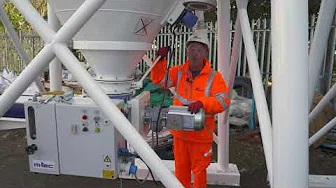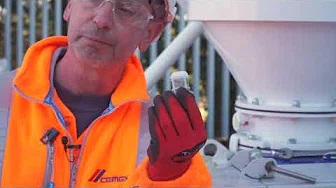Dry Mortar - Silo Video Guides
Welcome to our series of quick and helpful site user video guides, aimed to make it even easier to operate and resolve any potential operating issues for dry mortar silos.
Dry Silo Mortar Introduction
Hi, my name is Darren, I’ve been a service engineer for Dry Silo Mortar since 2002.
The main point of today is to go through the most common problems on site. But firstly, just take a point to mention PPE. Cemex recommends full Hi-Viz, hard hat, gloves and safety glasses. And when working in the dusty area of the silo, full face mask. And obviously, just be mindful of your work area, vehicle movements etc.
But before any maintenance can take place, the silo needs to be isolated. To do that turn your main power isolator on the control panel off, pull your main power supply. Run a quick test, make sure the panel is dead and we’re free to commence.
Dry Silo Mortar - Winter Working
One of the main problems during the winter period, is the water module on the dry silo mixing unit smashing due to frost damage, the sight glass and the pressure dome.
Simple remedy for this, the silo is designed so that the actual water box can be taken in of an evening. Before any work or any maintenance is done on the silo, it must be isolated. Isolate it at the main isolation point on the control panel and disconnect your main power supply.
Quick test to make sure the powers dead, then we can proceed. Firstly, just disconnect your water supply from the site supply, turn that off. Open your main drain valve on the water module, take the water off, then disconnect the main hose, undo the module from its bracket, it will just fall open. Close the pin back in which creates a handle. Disconnect the water pump which is a straight pull in/pull out socket, the solenoid is slightly different, it needs to be unscrewed before removing, wrap the pipe up, it can then be taken into your drying room, overnight.
Dealing With Dry Silo Mortar Blockages
Also, one of the main problems, is material too wet/too dry, intermittently, or shaft not turning correctly, a lot of this can be down to site maintenance, Cemex recommend that the silo is cleaned out, full strip, at least twice a week.
I’ll quickly go through this procedure. You will need two 19mm ratchet spanners for the bolts, which I have already loosened. So quickly, undo the front of your chamber, then slide off your front chamber. Place down. The front of your mixing shaft just slides off.
Any build up on your flights, just clean off, pay attention to your lead in screw, make sure there’s no built-up material around this area, clean your front spike and anything on it, basically, clean off. Then go around to back, before opening this make sure you have got your face mask on as this will be a dusty area, swing it open, take out your back section, water doesn’t get back to this, but moisture does so over time these threads do build up with material, take off any build up, give it a clean, reinsert it, slide it back in, locate it back into the jaws of the motor and close up.
Tighten up with the two 19mm spanners, then after cleaning your front section, relocate it back into the rear section of the shaft, paying particular attention to it sliding in, we can then feel it turning the motor, then have a quick check to make sure there’s no major build up, if there is, loosen it with a wrecking bar paying attention to the water inlet, make sure there’s no blockages there. Slide front section back on, and reattach the bolts using the spanners.
Handling The Butterfly Valve
Also, a major problem that can occur with the silo is the butterfly valve is stuck open, this occurs due to compaction of material in the butterfly valve, causes of this are if the site leave the handle open all day during production and come to close it at the end of the day or if they’ve tried to open or close whilst the silo is not working.
The only way then to rectify is to switch on the silo, have the silo move the material forward, once it starts to do that, grab your handle and with a rocking motion, rock up and down until you can close the silo off. Nothing you put on it will close it until you’ve released that compaction.
The second alternative is to full isolate the machine, you will need a face mask at this point, swing the motor open and as the material starts to trickle out, it will then release the compaction and you will then be able to close your butterfly valve handle off.
Dealing With A Seized Water Pump
Also, a problem that occurs from time to time, a customer will phone and say that on the silo a red light appears after filling a ¼ of a tub of product, this is a seized water pump, quick remedy is, open the water module and pull out the water pump plug, if you’re running on mains supply you don’t need this water pump so it can be disconnected.
Close it back up, whilst the silo is still isolated go into the control panel, and it will be Q2, it may just need resetting, closing your box up, reconnecting your power and away you go.
Managing Water Pressure
Also, water pressure can become an issue on site, firstly form a site point of view, make sure there’s nothing going off on site, i.e. no ones broke a main, none of the pipes have kinked, one of the main issues is from a site point of view they’re probably running at around 600/700 on the site dial if for some reason this drops, the main thing to look for is your filter in your pressure dome.
With a 30mm socket, undo your filter take it out, give it a good clean under the tap and replace it.
It’s as simple as that but that can cause big issues on site regarding your water pressure.





